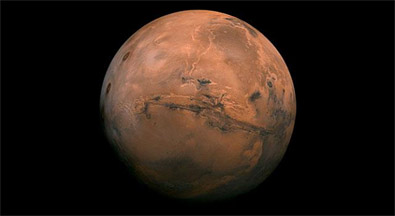
A recent study indicates that Mars might hold vast amounts of water beneath its surface, potentially enough to form a global ocean. The research, released on Monday, is based on seismic data from NASA’s Mars InSight lander, which recorded over 1,300 marsquakes before ceasing operations two years ago.
According to lead scientist Vashan Wright from the Scripps Institution of Oceanography at the University of California San Diego, this water is likely located between seven to twelve miles (11.5 to 20 kilometers) deep in the Martian crust, ABC news reported.
Wright explained that this water probably seeped into underground cracks billions of years ago when Mars had surface rivers, lakes, and possibly oceans.
ABC News reports that researcher Wright tempered expectations about the discovery of water on Mars, saying, “The presence of water on Mars doesn’t automatically mean it supports life. Rather, our findings suggest that there are environments on Mars that have the potential to be habitable.”
The team used computer models alongside InSight’s seismic readings to conclude that underground water was the most plausible explanation for the observed data. The results were published in the Proceedings of the National Academy of Sciences.
Wright added that if the underground water near InSight’s location at Elysium Planitia, close to Mars’ equator, is representative of the entire planet, it could be enough to fill a global ocean up to two kilometers deep.
However, confirmation would require drilling and other equipment to explore further and search for any signs of microbial life.
Although the InSight lander is no longer operational, scientists are still analyzing data collected from 2018 to 2022, seeking more insights into Mars’ interior.
Historically, Mars was wet almost all over more than 3 billion years ago, but as its atmosphere thinned, much of its surface water is believed to have either escaped into space or become buried underground.
Scientists propose warming up Mars by using heat-trapping ‘glitter’
The idea of transforming Mars into a world more hospitable to human habitation is a regular feature of science fiction. But could this be done in real life?
Scientists are now proposing a new approach to warm up Earth’s planetary neighbor by pumping engineered particles -similar in size to commercially available glitter and made of iron or aluminum – into the atmosphere as aerosols to trap escaping heat and scatter sunlight toward the Martian surface. The idea would be to augment the natural greenhouse effect on Mars to raise its surface temperature by roughly 50 degrees Fahrenheit (28 degrees Celsius) over a span of a decade.
This alone would not make Mars habitable for people, but the scientists who developed the proposal see it as a potentially doable initial step.
“Terraforming refers to modifying a planet’s environment to make it more Earth-like. For Mars, warming the planet is a necessary, but insufficient, first step. Previous concepts have focused on releasing greenhouse gases, but these require large amounts of resources that are scarce on Mars,” said University of Chicago planetary scientist Edwin Kite, who helped lead the study published this week in the journal Science Advances.




Be the first to comment